French troops defending Verdun came under renewed pressure in June-July 1916 as the German Army made its closest advances to the town.
The Verdun offensive, launched by General Erich von Falkenhayn in February with the aim of fatally weakening France, had become a war of attrition for both sides.
In an effort to regain the initiative, German troops made fresh attempts to break through the defences protecting Verdun on the right bank of the River Meuse.
June opened with the costly capture of Fort Vaux. The garrison commanded by Major Sylvain-Eugène Raynal, held out for almost a week. Raynal was forced to surrender on June 7th after his water supplies ran out.
On June 22nd, German forces opened another attack with phosgene gas shells. The following day, they overran the village of Fleury-devant-Douaumont and other key positions in their drive towards Verdun.
 The memorial chapel at Fleury – the German advance came closest to Verdun at La Poudrière, a munitions store near here in July 1916 (Photo: Centenary News)
The memorial chapel at Fleury – the German advance came closest to Verdun at La Poudrière, a munitions store near here in July 1916 (Photo: Centenary News)
The French responded with repeated counter-attacks. Fleury would change hands 16 times in fighting between June 23rd-August 17th 1916.
As the German pressure reached its peak, General Robert Nivelle issued his famous order: “Vous ne les laisserrez pas passer” (you shall not let them pass), a battle cry shortened to ‘on ne pass pas’ or ‘Ils ne passeront pas’ (they shall not pass).
German troops made a final attempt to capture Souville, a fort commanding the approaches to Verdun, on July 11th. They were then ordered back on the defensive, as resources were diverted to meet the challenges of the Battle of the Somme and Russia’s Brusilov Offensive on the Eastern Front.
Verdun, the longest single battle of the First World War, continued until December 1916.
CN Editor Peter Alhadeff visited Verdun in February 2016 for the opening of the redeveloped Verdun Memorial Museum near Fleury
Sources: Wikipedia/various
Images: Centenary News
